Pteridophytes are plants with Feather like Leaves
Pteridophytes are a group of primitive land plants belongs to the Cryptogams. They are the first evolved plant group with vascular tissue system for the conduction of water and food materials. Due to the presence of vascular tissue, they are called as Vascular Cryptogams. The term Pteridophyte is derived from two words ‘Pteron’ meaning feather and ‘phyton’ meaning plant. Thus, Pteridophytes are the plants with Feather-like leaves. Pteridophytes occupy the intermediate position between Bryophytes and Gymnosperms (seed plants). This post disicuss the General Characteristics of Pteridophytes.
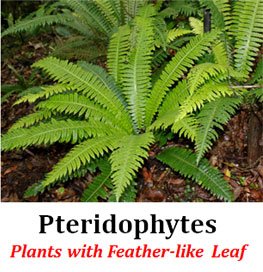
General Characteristics of Pteridophytes
Ø The division Pteridophyta includes primitive living and fossil vascular plants.
Ø They were originated in the Silurian period and flourished in the Devonian period.
Ø They are known as ‘Vascular Cryptogams’ – cryptogams with vascular system.
Ø They show heteromorphic alternation of generation with prominent Sporophytic and Gametophytic phases.
Ø The main plant body of Pteridophyte is the sporophytic plant (diploid).
Ø The gametophytic and sporophytic generations are two independent plants (not physically connected).
Habit and Habitat of Pteridophytes
Ø Pteridophytes show much variation in form, size, and habitat.
Ø Most of the present day Pteridophytes are annual, terrestrial and herbaceous plants. (Example: Psilotum, Selaginella Lycopodium).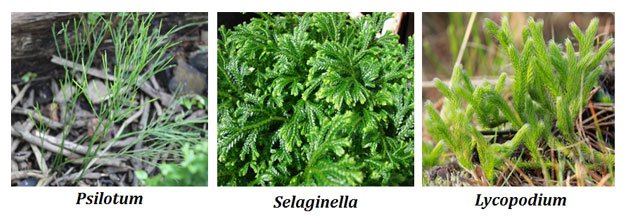 Ø Some are large perennial trees- Example Angiopteris, Alsophila
Ø Some are large perennial trees- Example Angiopteris, Alsophila
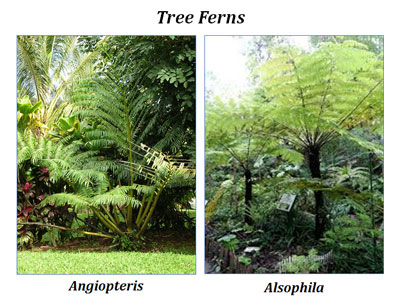
Ø Some Pteridophytes are aquatic (Example- Azolla, Marsilea, Isoetes, Salvinia)
Ø Few Pteridophytes are xerophytes (Example- Selaginella lepidophylla called Resurrection plant)
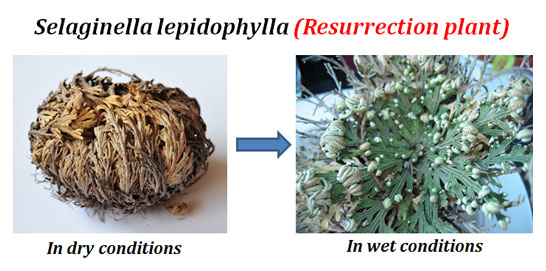
Ø Few are halophytes (Example- Acrostichum)
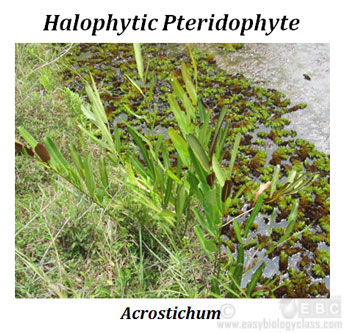
Stem, Root and Leaves of Pteridophytes
Ø The sporophytic plant body is differentiated into stem, root and leaves.
Ø Stem and roots have the permanent growing region at the apex.
Ø Most of the present day Pteridophytes are with herbaceous stem, some are woody.
Ø The stem is usually branched; the branching may be monopodial or dichotomous.
Ø Branches do not arise from the axils of leaves.
Ø The primary roots are ephemeral (short-lived) and they are immediately replaced by adventitious roots.
Ø The photosynthetic tissue is mostly restricted to the leaves.
Ø Based on the size, three types of leaves are found in Pteridophytes:
(1). Scale leaves: small minute scale-like leaf, Example- Equisetum
(2). Small sessile leaves: leaves are small without leaf stack (petiole), Example- Lycopodium, Selaginella
(3). Large, petiolate compound leaves: occurs in true ferns, Example- Pteris, Angiopteris
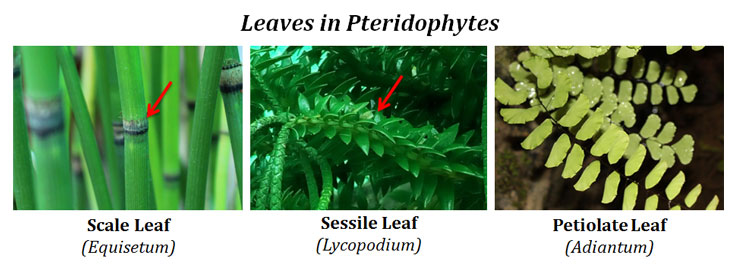
Ø In ferns, the young leaves show Circinate Vernation
Ø Circinate vernation: young leaves are curved inward, typically found in higher Pteridophytes and in some primitive Gymnosperms.
Learn more: Cycas: Morphology, Anatomy and Reproduction

Ø Based on the internal structure of leaves, the Pteridophytes are classified into groups:
(1). Microphyllous Pteridophytes:
@. Leaves are small and simple
@. Leaves possess a single vein at the middle region
@. No leaf gap formation in the stem
@. No tissue differentiation in the leaf
@. Example- Lycopodium, Selaginella
(2). Macrophyllous Pteridophytes:
@. Leaves are large and compound, usually pinnatifid
@. Venation is complex
@. Mesophyll is differentiated into palisade and spongy tissue
@. They form prominent leaf gap in the stele of stem
@. Example- Pteris
Ø Leaves and stem also possess many trichomes or hairs.
Ø Stomata are present and they are distributed on both upper and lower surface of the leaves.
Vascular Tissue in Pteridophytes
Ø Vascular elements are well developed in Pteridophytes.
Ø Root and stem possess well developed vascular system composed of xylem and phloem.
Ø There is a progressive advancement of vascular structure in different groups of Pteridophytes
Ø Vascular structures are commonly called as ‘stele’.
Ø Stele may be:
(1) Protostele: stele without pith (Lycopodium)
(2) Siphonostele: stele with centrally placed pith (Equisetum)
(3) Dictyostele: stele with leaf gaps (Pteris)
(4) Polystele: stele is differentiated into many vascular strands (Angiopteris).
Learn more: Stelar System in Pteridophytes
Ø Cambium is absent in the vascular tissue and thus no secondary thickening occurs.
Ø Some Pteridophytes such as Isoetes show secondary growth.
Ø The xylem chiefly composed of tracheids and very few parenchyma.
Ø Xylem vessels are completely absent.
Ø The phloem is made up of sieve cells and phloem parenchyma.
Ø Companion cells are absent in the phloem of Pteridophytes.
| You may also like NOTES in... | ||
|---|---|---|
| BOTANY | BIOCHEMISTRY | MOL. BIOLOGY |
| ZOOLOGY | MICROBIOLOGY | BIOSTATISTICS |
| ECOLOGY | IMMUNOLOGY | BIOTECHNOLOGY |
| GENETICS | EMBRYOLOGY | PHYSIOLOGY |
| EVOLUTION | BIOPHYSICS | BIOINFORMATICS |
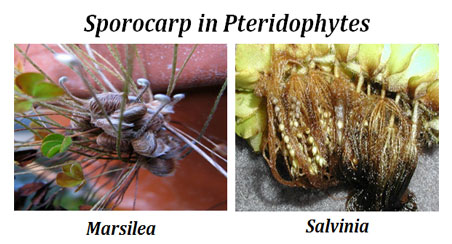 Reproduction in Pteridophytes
Reproduction in Pteridophytes
Ø Pteridophytes reproduce asexually by haploid spores.
Ø The spores are produced in specialized structure called Sporangia.
Ø Sporangia are borne on the ventral side of specialized leaves called Sporophylls.
Ø In aquatic forms such as Salvinia & Marsilea, the sporangia are present within a specialized structure called Sporocarp.
Ø Based on the size and nature of spores, two types of Pteridophytes occurs:
(1). Homosporous
(2). Heterosporous
(1). Homosporous
Ø Produce single type of spore and sporangia
Ø Spores are small in size
Ø Example- Lycopodium, Pteris
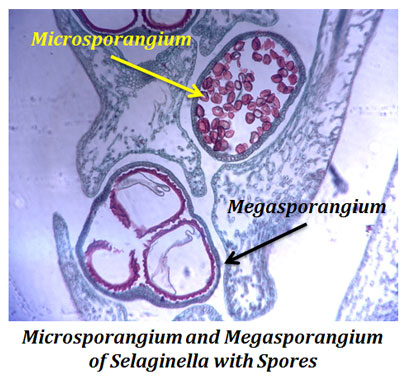 (2). Heterosporous
(2). Heterosporous
Ø Produce two types of spores and sporangia
Ø One is large and the other is small
Ø Large sporangia called megasporangia
Ø Megasporangia produce megaspores
Ø Megaspores are large in size and they are female spores
Ø Small sporangia is called microsporangia
Ø Microsporangia produce microspores
Ø Microspores are small in size and they are male spores
Ø Based on the development, two types of sporangia are present in Pteridophytes:
(1). Eusporangiate sporangium: developed from a group of initial cells (example: Lycopodium, Psilotum)
(2). Leptosporangiate sporangium: developed from a single initial cell (Pteris)
Ø The sporophylls may be either uniformly distributed (as in Pteris, Adiantum) or aggregated into a compact cone (strobili) at the end of the stem (Selaginella, Lycopodium, Equisetum).
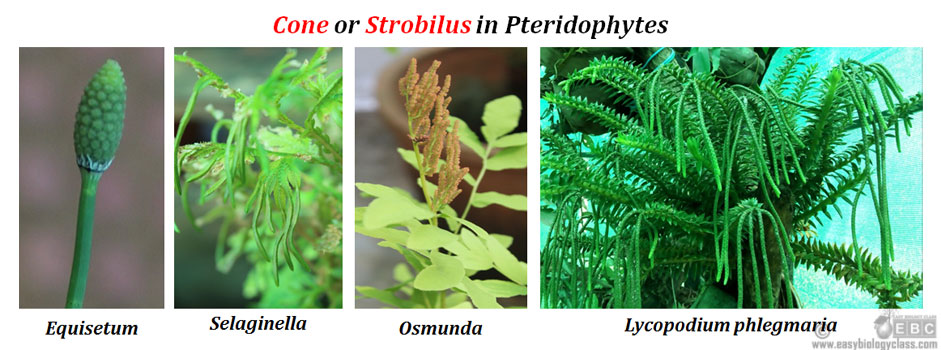
Ø In true ferns, the sporangia are located on the lower surface of the leaf as clusters called sori (sorus).
Ø The spores are with thick wall. The spore wall is differentiated into outer exine and inner intine.
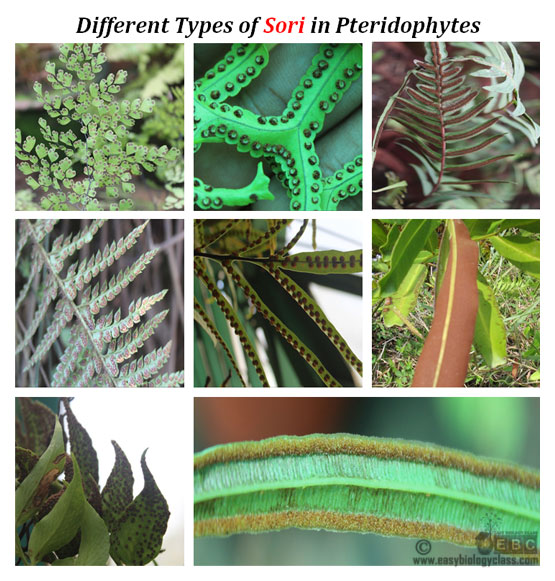
Gametophytic Generation of Pteridophytes
Ø The spores germinate to form the haploid gametophytic generation.
Ø Gametophyte and Sporophyte are two separate independent plants in Pteridophytes. There is no physical connection between these two generations.
Ø In Homosporous species, the development of gametophyte is exosporic (Gametophyte develops outside the spore wall)
Ø In Heterosporous species, the development is endosporic (Gametophyte develops within the spore wall)
Ø The gametophytic plant is called prothallus since it more or less looks like the thallus of a primitive bryophyte.
Ø In homosporous types, the prothallus is simple, green and heart shaped with many rhizoids.
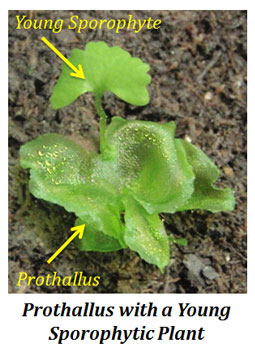
Sex Organs and its Development
Ø The Homosporous species are monoecious (antheridia and archegonia are borne on the same prothallus)
Ø Heterosporous types are always dioecious (antheridia and archegonia are formed on separate male and female prothallus respectively).
Ø Microspore gives rise to male prothallus which produces the male sex organ antheridium.
Ø Macrospore gives rise to female prothallus which produces the female sex organ archegonium.
Ø The sex organs are embedded or projected in the prothallus.
Ø The antheridium is surrounded by a sterile jacket of single cell layer thickness (for protection).
Ø The male gametes are called antherozoids, produced in mass inside the antheridium.
Ø Antherozoids are unicellular, spirally coiled or spindle shaped with two apical flagella.
Ø The archegonia are differentiated into a swollen neck and narrow venter.
Ø The archegonial neck is projected and the venter is embedded in the prothallus.
Fertilization
Ø During the archegonial maturation, the neck and venter-canal cell degrade to produce a mucilaginous substance which oozes out through the canal.
Ø This mucilage attracts the flagellated antherozoids towards the archegonium.
Ø Water is essential for completion of fertilization.
Ø The egg and antherozoids fuse to form the diploid zygote.
Embryo and Young Sporophytic Plant
Ø The zygote is the first cell of the sporophytic generation.
Ø The zygote divides many times to form the multicellular embryo.
Ø The first division of zygote determines the polarity of the embryo.
Ø The basal pole forms the foot and roots whereas the apical pole gives rise to shoot apex.
Alternation of Generation
Ø Pteridophytes show typical heteromorphic alternation of generation.
Ø The gametophytic and sporophytic plants are morphologically distinct.
Ø Gametophytic and sporophytic plants are two separate individuals without any physical contact.
Ø Diploid sporophytic phase is the prominent phase in the life cycle.
Ø Gametophytic phase is represented by a small but independent prothallus.
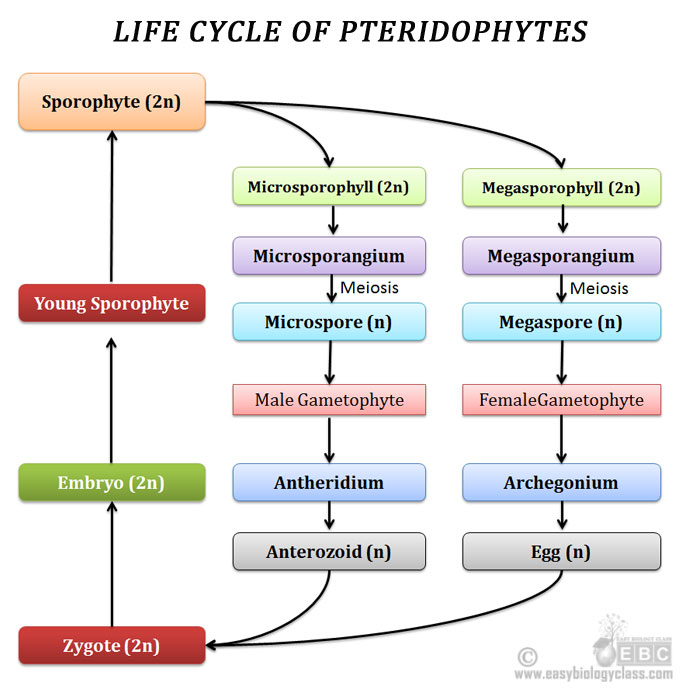
| You may also like... | ||
|---|---|---|
| NOTES | QUESTION BANK | COMPETITIVE EXAMS. |
| PPTs | UNIVERSITY EXAMS | DIFFERENCE BETWEEN.. |
| MCQs | PLUS ONE BIOLOGY | NEWS & JOBS |
| MOCK TESTS | PLUS TWO BIOLOGY | PRACTICAL |

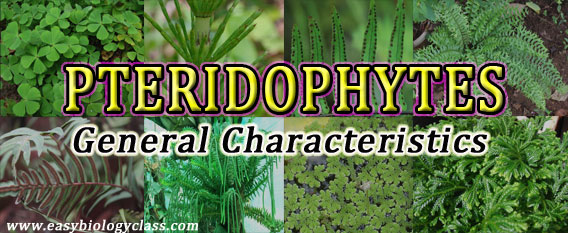
Great work